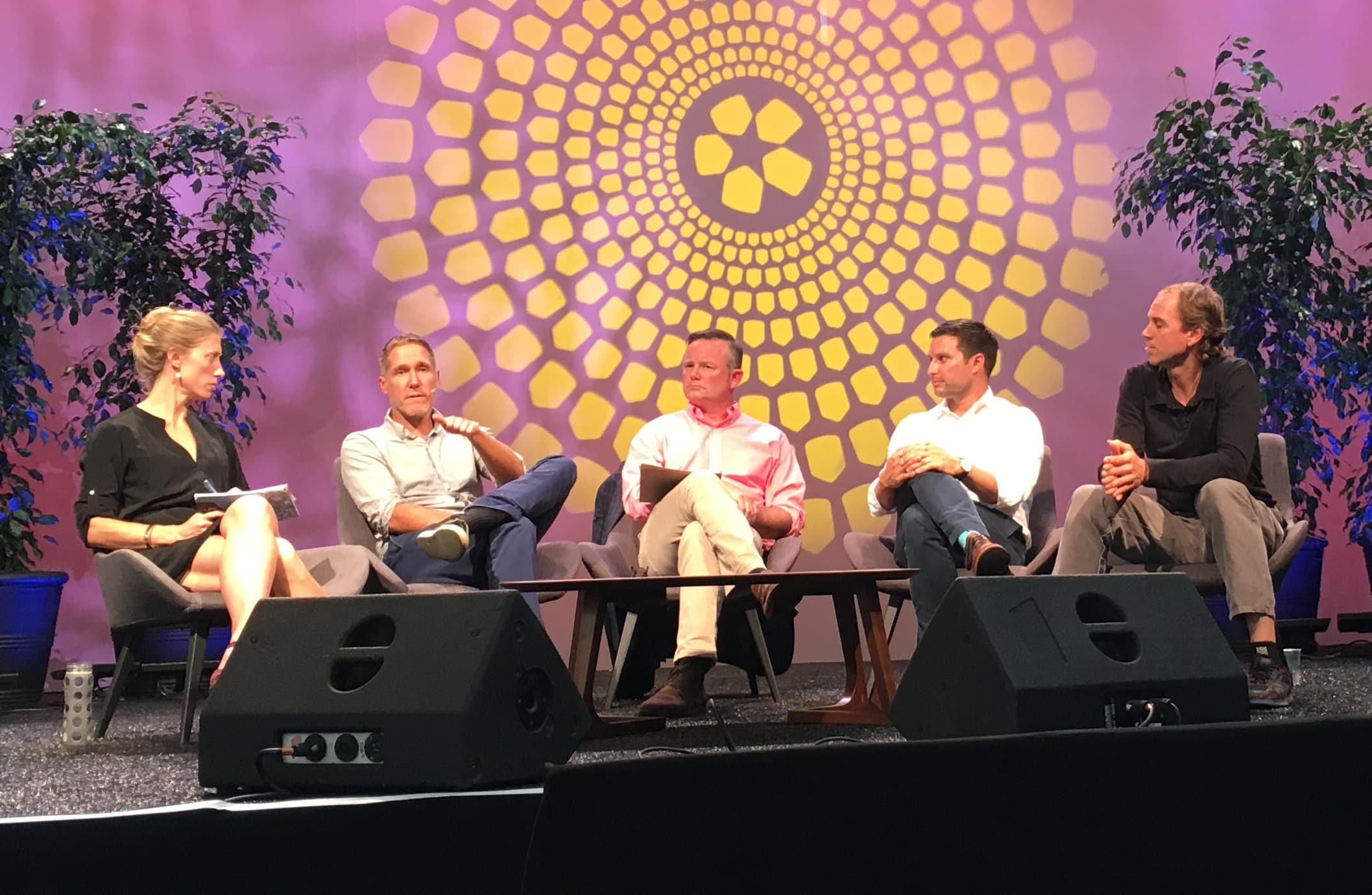
Kate Danaher of RSF Soical Finance, Les Szabo of Dr. Bronner’s, Scott Leonard of Indigenous Designs, Ben Schmerler of Root Capital, and Chris Mann of Guayaki Sustainable Rainforest Products take the stage at SOCAP15 to discuss funding fair trade supply chains.
Last week, more than 2,700 impact investors and social entrepreneurs met in San Francisco for the eighth annual SOCAP event. Below, we share a few takeaways and reflections on the state of the impact investing sector and what the keynotes, sessions, and conversations at SOCAP15 revealed about the future of the industry.
The (Continued) Mainstreaming of Impact Investing
Two years ago, the World Economic Forum released a report about the increasing popularity of impact investing and its steady move from the “margins to the mainstream.” As Bain Capital, the $75-billion-dollar investment fund, and BlackRock, the $4.7-trillion-dollar (yes, trillion) asset management firm, took the SOCAP stage to describe their new impact investing initiatives, that signal was clearer than ever.
“We need the world to move into thinking about social and environmental return as part of the overall return for investing,” explained former Massachusetts Governor Deval Patrick, who is now leading Bain Capital’s new impact investing initiative.
Bain and BlackRock are the latest entrants to what is often described as the “big tent” of impact investing. Earlier this year, Goldman Sachs moved further into the tent with its acquisition of Imprint Capital, and the Wall Street firm has recently taken social impact bonds to a new level.
The Tension between Achieving Impact and Realizing Financial Returns
As the field of impact investing becomes increasingly diverse, so do expectations around returns. Indeed, one of the most prominent conversations was about striking the balance between achieving social impact and realizing market-rate returns, a long-time tension within the sector that was almost palpable at this year’s event.
Two recent reports – one from the Global Impact Investing Network (GIIN) and Cambridge Associates (CA), and another from The Wharton School of the University of Pennsylvania – have challenged the perception among some that achieving impact necessitates a concessionary financial return. Released in June, the GIIN/CA report surveyed 51 private investment funds and concluded that funds with intent to create a positive social impact and target market-rate returns can, in fact, achieve (nearly) market-rate returns. More recently, The Wharton School released a study that tracked 53 impact investing private equity funds that also reported seeking market-rate returns. The researchers looked at 557 individual investments within those funds and found that certain market segments yielded returns close to those of public market indices between 2000 and 2014.
This left SOCAP attendees wondering if we need a more nuanced treatment of the bifurcated “impact first” or “finance first” investor framework. Either way, many people, including our own team, believe that there is still confusion when it comes to defining and measuring impact across the entire spectrum of return expectations.
As Root Capital’s CEO Willy Foote, Mike McCreless, and Brian Milder explained in a recent piece on the Stanford Social Innovation Review blog:
“We believe that over time the bar should be raised from intentionality to additionality. Additionality refers to the extent to which an investor’s capital, as well as non-financial assistance and participation in investee governance, are additional to what would have happened otherwise. In other words, if you want to change the world, you have to do something that wasn’t going to happen anyway.”
The Need for Holistic, Collaborative Solutions
If there was one theme from the opening day plenary panel, it was this: The system is failing, and finance is, as Brendan Martin, founder of The Working World said, “the most powerful force in the world” for solving local problems.
Many, however, were just as quick to extol the value of finance as they were to point out that it alone can also be a very blunt tool – and, it is often only part of the answer.
“You can’t just throw money into the system and expect impact,” said Scott Leonard, co-founder of organic and fair trade fashion company, Indigenous, during a panel on funding fair trade supply chains. For us at Root Capital, part of deploying capital in a smart and sustainable way means equipping our current and potential clients with skills they need to take on and repay our loans. Our advisory services – the financial management trainings that help businesses refine their accounting practices, for instance – are critical to our lending and ultimately, to our mission.
On a macro level, there seemed to be consensus that fixing the system with finance and other complementary tools will require us to collectively create the right ecosystem and the right enabling environment to unlock lasting impact.
“Sparks of the emerging future are among us here,” said Michelle Long of BALLE. However, she added, true systems change will come from not from competition, but from collaboration and compassion, a sentiment echoed time and time again in many of the sessions.
“We need that collaborative element,” said Chris Mann, CEO of Guayaki Sustainable Rainforest Products, speaking specifically on the need to build more holistic supply chains. “We can all leverage each other and see what works.”

